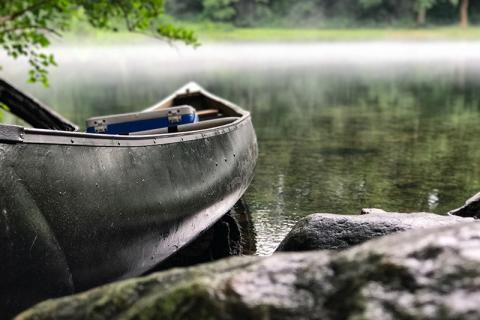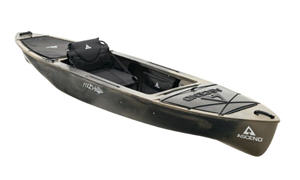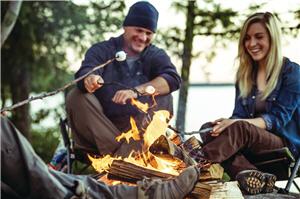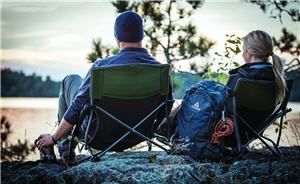
So you’re ready to cast off the bowlines, drift away from the campground, and spend your first night sleeping on the riverbank? Don’t worry, planning an overnight float trip is not as daunting as you think, and the work is well worth the reward.
1. Choose the Right Canoe or Kayak
 |
| Ascend DC14 Canoe |
The first step is picking the perfect vessel for your trip. If you’re planning an overnight float, chances are high that you’ve already become comfortable on the water with either a canoe or kayak. While there are benefits to each, it’s probably best to stick to the type of boat you are most confident handling.
A canoe is the classic float trip vessel. With plenty of room for storing gear and space for children or pets to ride along, canoes like the Ascend DC14 are perfect for families. When selecting a canoe, be sure to consider the type of water you’re likely to float. A deep, heavy canoe will provide more stability in large lakes and rivers; while a shallow, lighter canoe will glide through low water and make frequent portages a breeze.
 |
| Ascend H12 Sit-In Hybrid Kayak |
Many solo paddlers consider kayaks easier to maneuver and more comfortable for long floats. This often comes with the tradeoff of less storage space and no room for your four-legged fishing buddy. A hybrid kayak like the Ascend H12 can be the perfect solution for stashing all your gear while still maintaining agility on the water.
Large groups may find it best to have one or two canoes for toting all the gear, while the rest of the party enjoys the flexibility of smaller kayaks. Paddlers can always switch to alleviate cramped legs or tired shoulders if needed.
2. Streamline Your Camping Gear
Packing for an overnight float is a little different than unloading your car at the local campground. Filling your SUV to the brim and heading down the highway is no longer an option. Each item you include will take up space and add weight to your vessel, so it’s important to streamline your gear to only the essentials.
 An important rule of thumb—which is often only be learned by experience--is that everything you take on a float trip WILL get wet. Leave all expensive electronics and valuables at home unless they are absolutely necessary. Essentials that must stay dry should be stored in a Ziploc bag, in a dry box, inside of a dry bag. Large dry bags are also great for packing clothing, sleeping bags, and other gear. Don’t rely on a trash bag to keep water out, and be sure to throw in a clothesline for good measure.
An important rule of thumb—which is often only be learned by experience--is that everything you take on a float trip WILL get wet. Leave all expensive electronics and valuables at home unless they are absolutely necessary. Essentials that must stay dry should be stored in a Ziploc bag, in a dry box, inside of a dry bag. Large dry bags are also great for packing clothing, sleeping bags, and other gear. Don’t rely on a trash bag to keep water out, and be sure to throw in a clothesline for good measure.
Use bungee straps or paracord to secure all gear inside your kayak or canoe. Someone will inevitably take a tumble, and scouring the riverbank for missing items is no way to spend the afternoon. Tie up all loose ends to ensure no people, pets, or tree limbs can become tangled.
3. Pack Accordingly for Going Off the Grid
Many of the best paddling trips will take you far away from civilization. Don’t forget to include the items you often take for granted back home. Hand sanitizer, cooking oil, toilet paper, fire starters and bottled water are all essential to a safe outing.
Other creature comforts such as a high-quality sleeping pad and some sort of camp chair will also make a world of difference. Rocky river banks are beautiful, but can be torture if you arrive unprepared.
 |
| Cabela’s Polar Cap Equalizer |
A lack of civilization also means a lack of ice. Keeping food and beverages cold on long trips can be a challenge. A good cooler, such as the Cabela’s Polar Cap Equalizer, can be a valuable asset. Some floaters will fill one cooler with perishable food, and another with drinks--vowing to only open the food cooler when absolutely necessary.
4. Prepare Your Float Route & Check Conditions
Before embarking on your trip, carefully plan your entire route. Make notes of important landmarks and checkpoints. Pinpoint potential early take-out spots in case of emergencies, and make sure you know what your final destination looks like from the water. It’s easier to float right past the truck than you might think!
Communicate your route, along with takeoff and arrival times with someone not on the trip. Provide them with instructions on what to do if you do not check-in on time.
Keep a close eye on water and weather conditions leading up to your float. Feel free to contact a local conservation agent or paddle rental service. They are very in-tune with conditions and often happy to provide advice. If water levels look risky or flash flooding is possible, it’s best to live to paddle to another day.
5. Take Your Time & Enjoy
 While these trips require an abundance of planning and preparation, slipping into the water and drifting away from civilization makes the work well worth it in the end.
While these trips require an abundance of planning and preparation, slipping into the water and drifting away from civilization makes the work well worth it in the end.
Take time to paddle like crazy, skip a few rocks, and soak up the flicker of a campfire on some secluded piece of shoreline. If you’re not careful you might start planning your next trip before you’re even off the water.
Before you go, be sure to brush up on 5 Different Strokes for Paddling Folks.
- 4245 views

